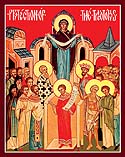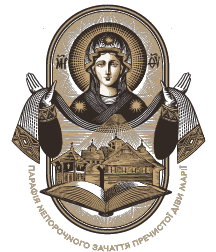
August 15th Recalling that our Byzantine Church year begins on September 1st (not January 1st like the civil year), the last feast we celebrate is fittingly the ‘Dormition’ of the Mother of God In our calendar, the first of the great feasts is the Birth of the Virgin (September 8th). The we re-live all the events she lived through: the Annunciation, the Birth of Christ-God at Christmas, the Holy Baptism in the Jordan, the public ministry of Christ, the Passion, the Cross, the Tomb, the Resurrection, the Ascension and the Descent of the Holy Spirit at Pentecost. Now finally, as if to close the frame, we come to the end of the Virgin’s life on earth. We have no reliable historical documents about how Mary’s life came to end. Some say she died in Ephesus where she lived with St. John the Apostle. Our Liturgical texts say she died in Jerusalem. But that is not proven anywhere – it is only popular belief. It is our ‘Tradition’ and not an article of faith that is equal to the Incarnation or Resurrection of Christ. It just exists in the living memory of the Church, a memory which is especially strong in the Eastern Church. Our emphasis on the ‘Dormition’ of the Virgin, that is, her passing from life to death to eternal life in Christ parallels our approach to the Resurrection of Christ. Mary is Christ’s first and greatest disciple, and as any good disciple, she imitates the Lord and teacher. She knew her own passion (“a sword shall pierce your heart”) and, now, death and resurrection. God could not allow the body of the Mother of God, the flesh which had given Christ flesh, to know corruption, so the angels came to bring Mary to heaven with her body. There were witnesses to Christ’s Ascension, and it is told in Scripture. There is no proof of Mary’s ascent, which we call her Assumption. However, the Church Fathers have always held that this honor was given to Mary, and that now, she is glorified in heaven, in the body. Mary is unique and wonderful. There are many saints in heaven, but these must await the final day of judgment for their bodies to be raised, and for them to be ‘whole’ again, body and spirit. Their bodies remain in their tombs. We venerate them as relics; nearness to these sacred bodily remains of the saints is a great blessing to us. They are ‘matter’, stuff of the earth, which will be glorified on the great day of the Lord’s coming. How this will happen, what it might be like, we might wonder. Whatever that great process will be, it has already happened to the Mother of God! Her relics are not among us. Her tomb in Jerusalem lies empty, yet still gives off a wonderful fragrance, because for three days she lay there as the apostles and the Church mourned. Today, the Church rejoices. Yet again, in his Mother, God has provided a sign of the Resurrection, a promise of the future glory we all hope to enjoy on day. Mary is the faithful disciple, who carried out the will of God with a generous spirit. She accepted Christ, and bore our Savior within herself in love. Now Christ accepts her, and bears her to the throne she occupies in heaven. She is the sign of hope, the proof of Christ’s merciful love, the first among the redeemed, the highest among our race. Indeed, she is more honorable than the cherubim, and beyond compare more glorious than the Seraphim, for they are only spirits, she in the flesh, glorifies God in the flesh. On the great feast of her Dormition, her ‘falling asleep’, we magnify her and stand among the generations which call her blessed.
Written by a monk of the Byzantine Church. Copyright ©1998 http://www.byzcath.org.


